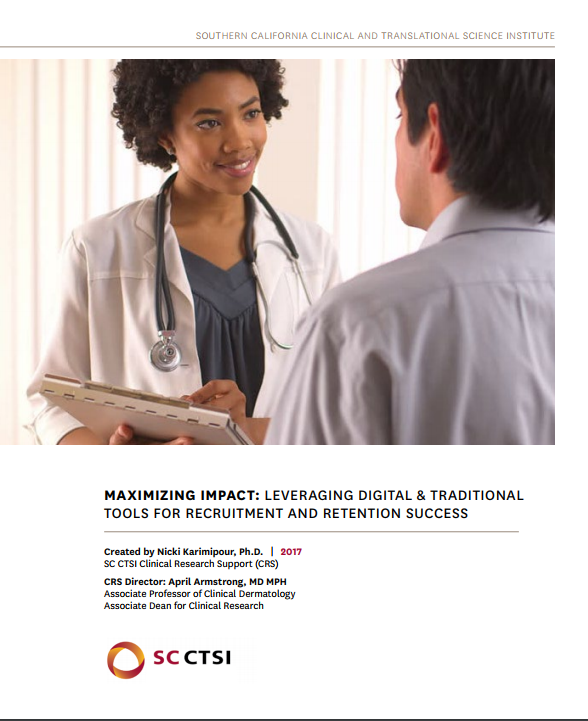SC CTSI Publishes Handbook On Uses of Digital and Traditional Media to Recruit Study Participants
The latest in a series of SC CTSI "toolkit" publications for clinical investigators details techniques to connect with study populations in all communities.
Finding and enrolling participants in clinical studies has always been a difficult part of the investigator's job. Retaining participants for the study duration can be just as hard. This has led to a high percentage of studies that never make it out of the gate, for lack of participants, or that yield weaker findings due to participant drop-out. And these recruitment issues have actually worsened in recent years, particularly for investigators seeking to field much-needed studies among diverse and minority communities.
The good news is that clinical investigators have more ways than ever to reach out to potential participants and even entire communities, said recruitment specialist Nicki Karimipour, PhD, Program Manager in the SC CTSI's Clinical Research Support group.
Traditional methods for engaging participants, used by researchers for decades, have been augmented by fast-evolving generations of increasingly versatile digital media and communication tools, including smartphones and social media platforms such as Facebook and Instagram, not to mention ordinary email and text-messaging.
A game-changer for study recruitment.
These tools give investigators powerful, flexible, and cost-effective avenues to connect with individuals and entire communities, in their home region or across the country.
"New digital technologies are indeed recruitment game-changers for clinical researchers," said Karimipour. "But in order for their outreach strategies to work, it's crucial that investigators have a master plan in place before they start the process."
To help clinical researchers develop a solid plan, the SC CTSI has created a guide containing proven strategies and tips: Maximizing Impact: Leveraging Digital & Traditional Tools For Recruitment And Retention Success.

"This new guide is meant to detail best practices in both new and traditional forms of media with respect to recruiting and retaining participants for study trials," said Karimipour, who wrote and compiled the 16-page booklet. "The handbook can help researchers make sense of the many options out there and find guidelines for integrating them into a strategy that makes sense for their study goals."
The NIH's NCATS has identified recruitment and retention as key concerns in the nationwide effort to overcome longtime obstacles in multisite clinical trials, and has provided funding opportunities for the creation of trial and recruitment innovation centers at CTSA hubs.
Cultural concerns, linguistic nuances.
As noted, the SC CTSI seeks to help researchers do more than merely ensure sufficient numbers of trial participants. It's also working to help overcome the longstanding underrepresentation of minority and nonwhite communities in research. But reaching diverse populations also requires a grasp of the cultural concerns and linguistic nuances unique to different ethnic and other groups.
In addition to reviewing the new toolkit, researchers can arrange an individual consultation with Karimipour, who will assist in the development of a recruitment and retention plan.
Maximizing Impact: Leveraging Digital & Traditional Tools For Recruitment And Retention Success, is available for download to clinical and translational researchers in the USC/CHLA research community. For information about the toolkit, or to arrange a recruitment consultation with Nicki Karimipour, contact her at 323-442-1280 or nicki.karimipour@med.usc.edu.



